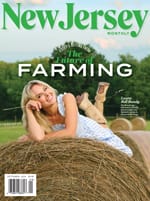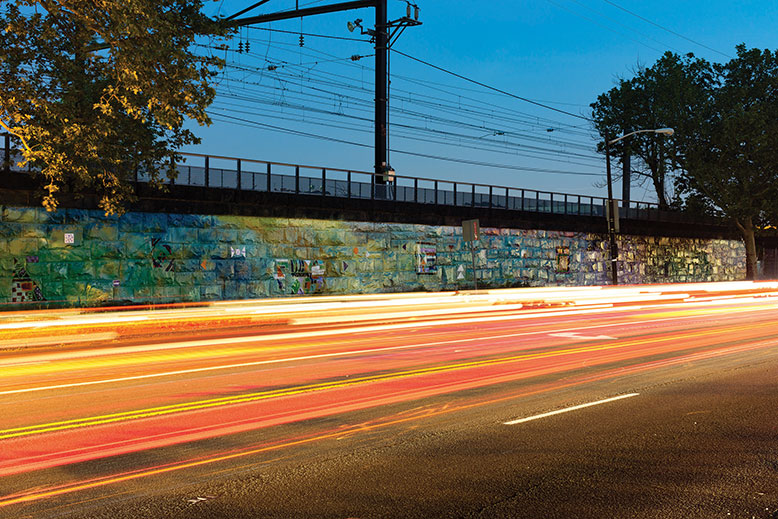
Photo by Cody Rasmussen
The headlines from Newark are getting better these days. Consider this one: The city is now home to the longest mural on the East Coast. It’s a masterpiece of public art that must be seen. In fact, it’s hard to miss.
Gateways to Newark: Portraits, as the mural is officially known, stretches 1.39 miles. That’s about the length of 25 football fields. It adorns the pocked and pitted, 110-year-old Amtrak retention wall below the tracks running along busy McCarter Highway (Route 21) from Hamilton Street to the routes 1 and 9 on-ramp.
Local curator Rebecca Jampol chose the 18 artists who painted Portraits (some working in pairs). Each artist—10 from Newark, the rest from as far as Brazil—was tasked with developing a concept tied to Newark’s culture and heritage. The resulting 16 panels—each up to 1,000 feet long—call out to passing drivers and cyclists with distinct, and sometimes personal, Newark stories. (For the record, the nation’s longest mural, according to Guinness World Records, is painted on a levee along the Arkansas River in Pueblo, Colorado.)
On these pages, we introduce you to eight of the artists. Since Amtrak owns the retention wall, everyone who labored on the mural, including the artists, 22 artist assistants and dozens of ambassadors from the Newark Downtown District, was required to pass an online certification program in order to work on a railroad. In this case, not all the live-long day, but in the middle of the night. Because traffic along McCarter Highway could not be rerouted during the day, the artists worked from 8 pm to 5 am for 13 days in May. Thirty-five stadium lights illuminated their canvas. Seven high-tech projectors, donated by Panasonic, cast the design blueprints onto the wall. Some 350 traffic cones were used to close off one lane of traffic.
“Some nights they worked in light rain,” recalls Noelle Frieson, director of marketing and business strategies at the Newark Downtown District, which spearheaded the mural. Some artists took late-night naps in sleeping bags on the grass near sidewalks; many bonded over roadside snacks. By the time they finished, they had gone through 1,500 gallons of paint, most of it donated by Sherwin-Williams. (Panasonic, Frieson says, was another big donor; a few private donors also kicked in, but most of the mural’s six-figure budget was picked up by the city.)
Once painting was complete, the mural was washed with anti-graffiti sealant to protect it. “You can scrub off any graffiti with a wet cloth and the mural will still be intact,” says Frieson.
The mural is the first of many facelifts the Newark Downtown District organization has planned for the city’s entry points under its Gateway to Newark beautification project.
“We are seeking to change first impressions,” Frieson says.
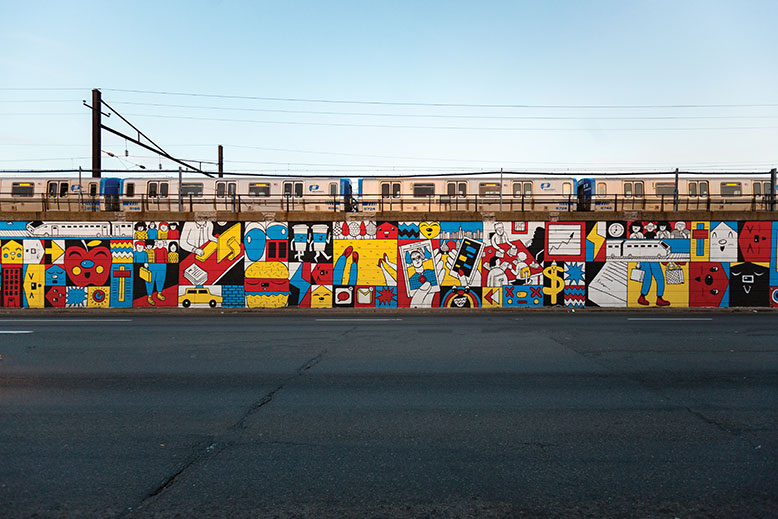
Photo by Cody Rasmussen
Artist: Sonni
Hometown: Buenos Aires, Argentina
On The Web: sonnistudios.com
Instagram: @sonni
Title of Work: A Long Day
“I wanted to capture the everyday—people walking, talking, commuting. I’m from Argentina, and I live in Brooklyn now, but I had been to Newark a few times before I heard about the mural. The times I went over there, to Newark, I saw so many people moving, going to Manhattan and coming back from Manhattan. It’s a busy place, with a lot of movement. Based on what I saw, I had an idea to do something about routine. I didn’t want to be just, like, this is the good and this is the bad about Newark. I wanted to show how real life looks. When I started painting I was surprised. I felt like, Oh, no, I have a whole block to paint. I had only done something like that a couple of times before. And the hours were crazy, but I didn’t mind that because art is a passion and once you get going you don’t want to stop. Also, I started looking around at the neighborhood and I realized, this is something important I’m doing for the city, and maybe in some way I can affect this city positively. That was important to me because I really like the people I met in Newark. They’re open to talking, to friendship. They’re a little more open than people in some other places. And the food is good—much cheaper than in Brooklyn.”
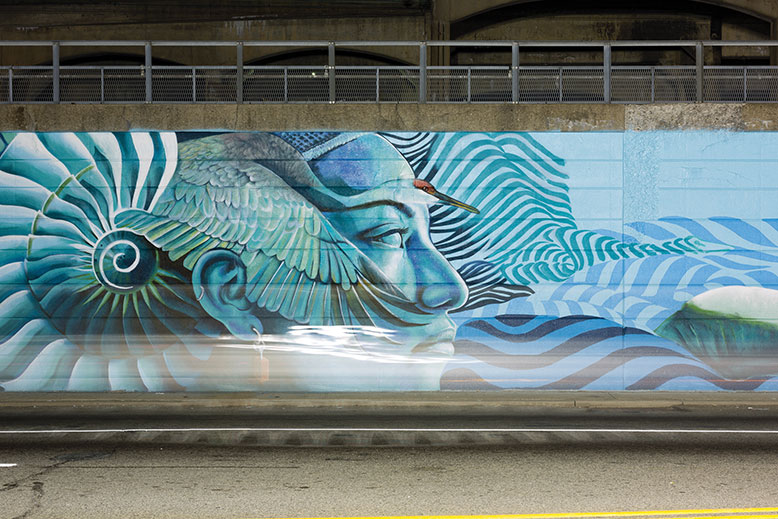
Photo by Cody Rasmussen
Artists: Gera & Werc
Hometown: Gera was raised in Newark; Werc is from Mexico; both live in Brooklyn
On The Web: wercworldwide.com, geralozano.com
Instagram: @w3rc, @geraluz
Title of Work: Newark Portal Flow
(As told by Gera): “When we heard about the project, we were so excited because we love research, and we love history, and public art and community empowerment is what we’re focused on. So we liked the guidelines, where the art had to tell something about the city. With Portal Flow, we decided to create our own iconography. So it’s not the Statue of Liberty you see on the mural, it’s Newark’s Lady Liberty. She represents the earth, the spirit of flight and its creatures, like the cranes in the Passaic River. The Port of Newark, on the right, represents the male, the mind and the industries that shaped the city. The male and female meet, and magic follows. The waters move, the cranes fly and the energy is alive in all the fish and ships carrying their goods. Every element in the mural is symbolic. The fish in the mural is a brook trout, the New Jersey state fish. The lion in the center of the design is an homage to the architectural ornaments of Penn Station. The containers are a recurring element of the port. They reflect Newark’s international economy and public art…The project was special for me because I grew up in Newark, and my grammar school was two blocks away from where we were painting. Now when I come home and I’m out with my family, we’ll be doing something like picking up barbecued chicken and the guy at the counter will go, ‘Oh, you’re the artist.’ My family loves it. They’re so proud.”
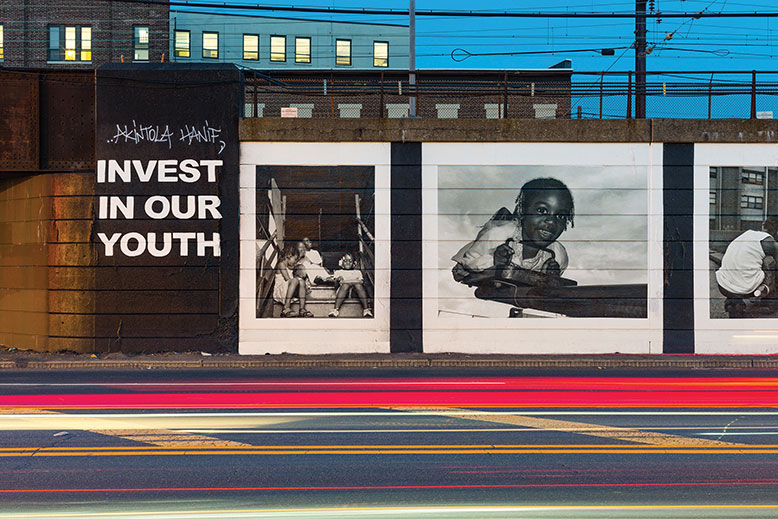
Photo by Cody Rasmussen
Artist: Akintola Hanif
Hometown: Newark
On The Web: hycide.com
Instagram: @hycide
Title of Work: Invest in Our Youth (Never Forget the Ones That Need Us Most)
“I’m originally from Brooklyn, but the young people you see in the pictures are from a housing project on the border of Newark and East Orange. Part of my family used to live there, and I started coming to visit them when I was around 15. They were my introduction to Newark before I moved to New Jersey in 1996. I took the photographs when I got out of school in 2003, my first photo series ever. The reason I took them was because the housing project was going to be torn down in 2004; I wanted to be sure it was documented. There’s a common misconception about people in the projects—that they’re in bad circumstances. These people had good jobs and went to school and had good lives. It wasn’t like it was a rat-infested drug slum. This was a three-story housing project, like what I imagine would be in an African village. The good thing is that the housing project has a Facebook page—they have reunions every year—and I’m connected on social media to all the kids I photographed. I reached out to them and asked all of them permission to use their photo on the mural, so they all know about it, and they were all super proud. One of the things that stands out to me is the photo of a young boy playing with an eggbeater in a puddle. You never see a kid playing with an eggbeater anymore, no less playing with an eggbeater in a puddle. I caught his reflection in the puddle, and it became my first signature image. It’s the second image I ever sold as a professional photographer, and it’s also special to me because the kid is my friend’s son. He’s in college now, and he’s six feet tall and 200 pounds. When I took that picture, he was maybe 60 pounds. My part of the mural is titled Invest in Our Youth and that’s really what I’m trying to say. Don’t forget about the young people in this city.”
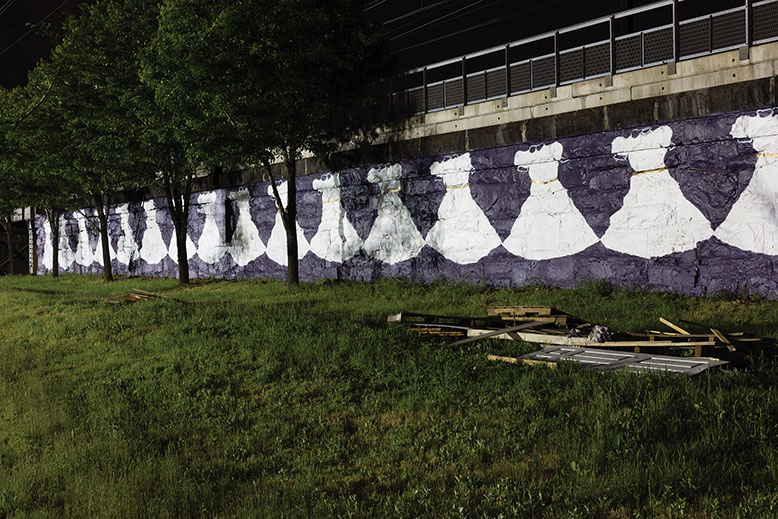
Photo by Cody Rasmussen
Artist: Adrienne Wheeler
Hometown: Newark
On The Web: facebook.com/adrienne.wheeler.12
Title of Work: 42 Dresses, 2016
“My part of the mural touches streets that are significant in my family. Right Street is where my dad grew up, and Miller Street is where he went to school. If you’re walking behind the mural on Railroad Avenue, there are two streets there; my paternal grandparents were born on those streets, and they later married in Newark in 1887. The dress you see on the mural is from my mother’s grammar-school graduation in 1942. It’s a little white Swiss-dot dress she made in sewing class in preparation for graduating from Morton Street Elementary in Newark. She wore it, then she put it in her mother’s cedar chest. It stayed there for 70 years until I dug I out. I gave it a two-minute hand wash in warm water with a drop of bleach, and then I photographed it. It became my vision for the mural. My mother was from Georgia, but she moved to Newark in 1938 as part of the Great Migration; the dress, in its mural form, is now right under the very railroad tracks she traveled to get here. I didn’t know how many dresses I’d end up with on the mural, but I knew I wanted the hems to meet so they resembled a paper-doll cutout. We ended up with 22 on one wall, and 20 on the other side, so that was 42, the year of her graduation. While I was painting the wall, there were times when a train would go by and the vibration would go right through your hand. So I was literally in touch with the energy of the railroad, and the dresses were in motion, and it felt like the motion of my mother’s life and my grandmother’s aspirations for her. I’m so glad I was able to document it.”
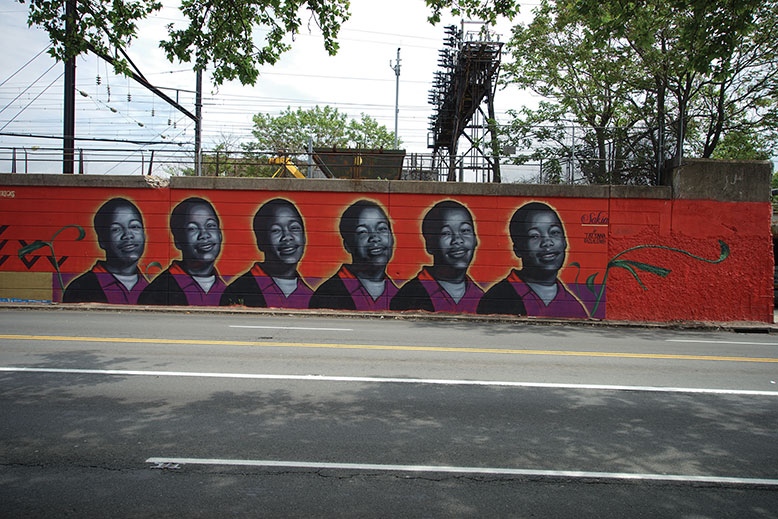
Photo by Cody Rasmussen
Artist: Tatyana Fazlalizadeh
Hometown: Brooklyn
On The Web: tlynnfaz.com
Instagram: @tlynnfaz
Title of Work: Sakia, Sakia, Sakia, Sakia
“Sakia Gunn was a teenager in Newark who was stabbed by a man after she and her friends refused him on the street. Sakia was 15, black, a girl and gay. This happened in 2003. She was with her friends, and they were outside coming home from a night out when these guys approached them. Sakia died from the stabbing. I repeated the image on the mural multiple times for impact and emphasis. Just like with the title, I wanted her name to be said multiple times. Originally when I was contacted about the mural I was going to do a large group of women in black and white, a paper installation. But at the last minute I stopped, because through my recent work—like Stop Telling Women to Smile, a street art project with portraits in different cities addressing gender-based street harassment—I’ve gotten to know a lot of women and girls who have stories like Sakia’s. Tragic stories that come out of women just hanging out wherever they live and experiencing violence. I knew about Sakia’s story a couple of years earlier, and I just put two and two together—it would be fitting for me to do a portrait of this person who was a Newark resident for this project about Newark. She was deserving of a tribute. She should be seen and visible. And people have shown their appreciation. I’ve gotten a lot of feedback online from Newark residents who have reached out and congratulated me.”
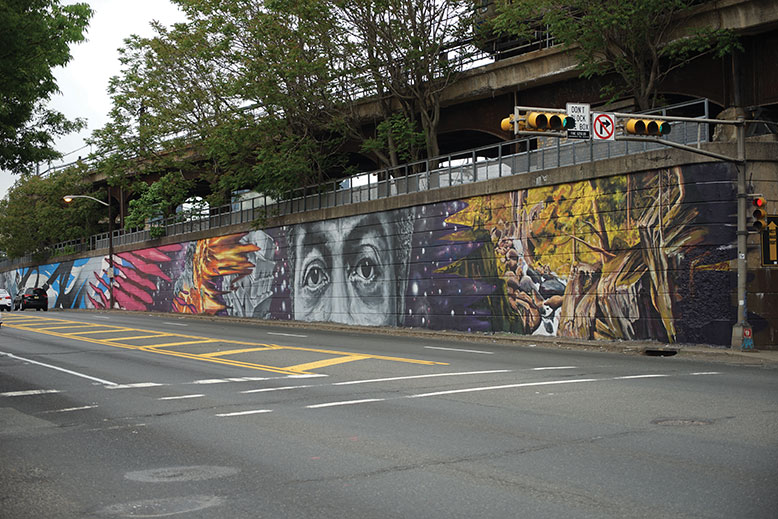
Photo by Cody Rasmussen
Artist: David “Nanook” Codgill
Hometown: Baltimore
On The Web: nanookstreetart.com
Instagram: @nanookoso
Title of Work: A Man is Either Free or He is Not: Amiri Baraka
“Getting work painting murals [is] really hard to do. So it was amazing for me to be a part of this. I don’t suspect that everybody who drives by will know those are Amiri Baraka’s eyes I painted, but a lot of people who have spent time in Newark will. I got introduced to Baraka’s writing a while ago, before [his son] Ras Baraka became mayor, and really, it’s just his extreme passion that moved me. Newark has a diverse population, and so you have to pick your own standpoint—if you’re going to be heard, you have to know who you are first, and be able to share that perspective. In a city with different points of view, you need strong personalities. People with inner strength. Like Baraka. Other things I painted on the mural, like the plane, are a direct representation of the transportation industry that’s so prevalent in Newark. People are going to derive their own meaning from my part of the mural, and that’s good. That’s the meaning of public art. More than anything, when making a mural I’m hoping I’m going to get people doing their own investigations and forming their own insights. Hopefully somebody will be like, ‘Why are there planes? Why are there tires?’ It’s a jumping-off point for people to come up with their own ideas about the city.”
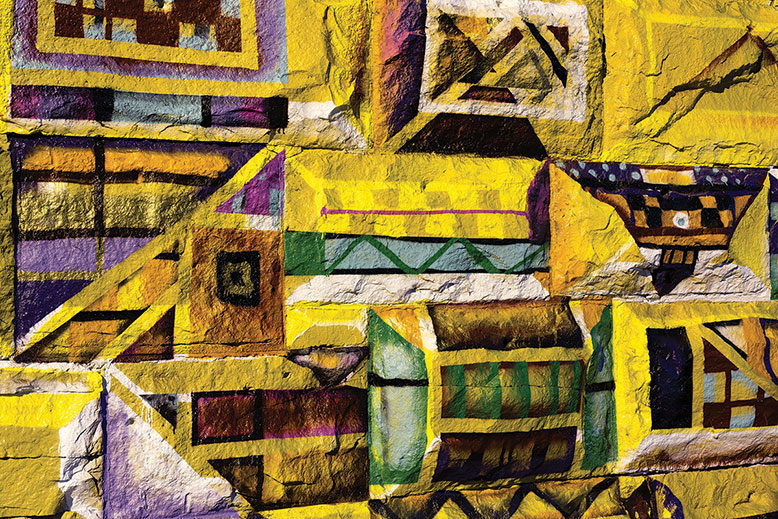
Photo by Cody Rasmussen
Artist: Kevin Darmanie
Hometown: Newark
Instagram: @kedarman
Title of Work: Code to Freedom: A Legend De-Constructed
“Before I got the call about the mural, I had been researching Nubian quilts. I was familiar with the Gees Bend quilts from Alabama, and I knew that Newark is connected to the rest of the world because it’s a transportation hub. We were working on a train line, and so that made me think of the Underground Railroad, and how quilts were used to sort of communicate with runaway slaves. If they saw a quilt hanging at someone’s house, there was some symbolism that let them know whether it was safe to stay there or not. So the train line became like a metaphor for the Underground Railroad…I initially wanted to cover my whole part of the wall with painted quilts. But when I saw the wall, I realized it was going to be a problem because of the texture. That wall absorbed so much paint, it was like trying to paint crumpled paper. So I deconstructed the idea of the quilt and made it into a series of shapes and symbols so it looked like a hidden language, like a code people could try to crack, like the quilts were code on the Underground Railroad. Working overnight was fun because you got to meet all the other muralists, but we had to wear hard hats and vests, so it was taxing: it’s not like you’re out in the sun and there’s pretty girls driving by. It was cold and wet, and you knew you were going to be back there the next day at 3 am, and sometimes there were equipment problems. But we felt like local celebrities for a while, and this is my city, so any opportunity to get people seeing it in a positive light is well worth it to me.”
